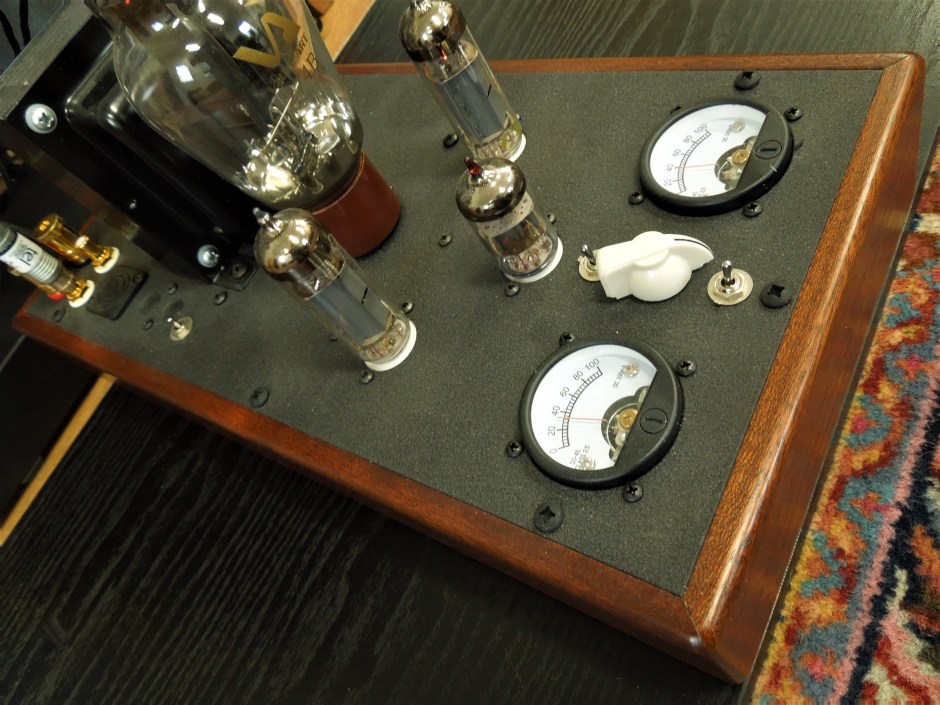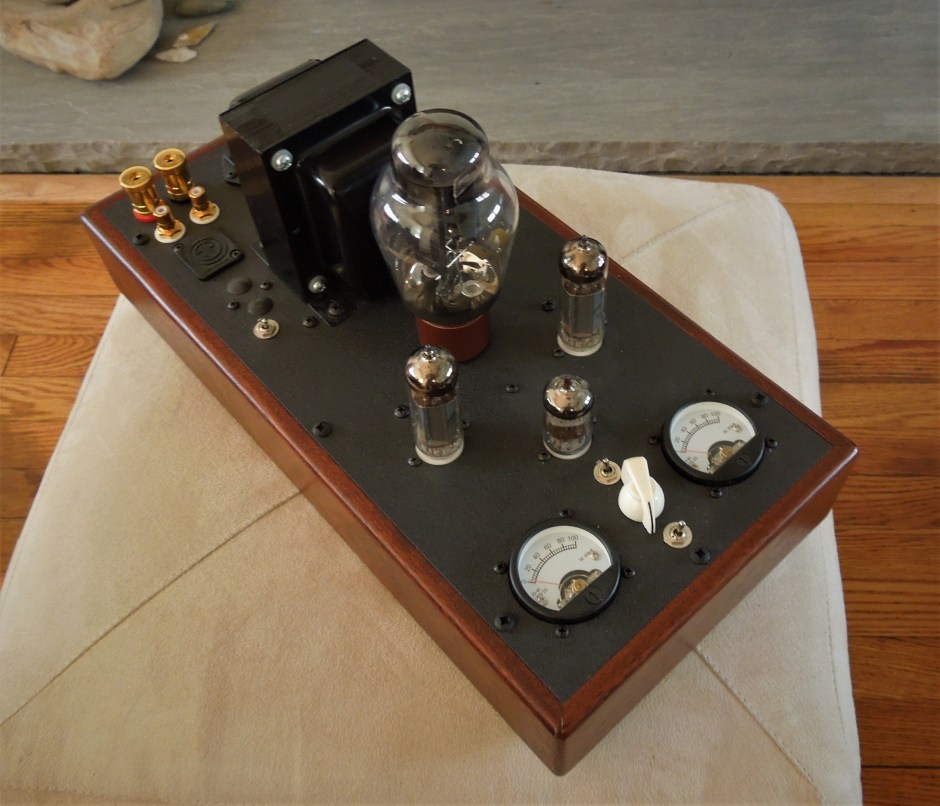
First, a disclaimer. I own this Decware Zen Triode amp and bought it for myself, so it’s not a typical “loaner” that we reviewers normally get to evaluate. Steve Deckert, Decware’s head guy, normally doesn’t believe in supplying reviewers with samples. If I want to review the product, his policy is that I buy it, at full price, just like any other customer.
That’s exactly what I did. I let Steve know I was a reviewer, but didn’t ask for any accommodation, nor was I offered one. This is Deckert’s policy, and I respect it. And judging by how busy the man is (as reflected in the number of amplifiers his small
operation builds and sells), I doubt he really needs baskets of glowing reviews to peddle his products.
However, after a very recent communication with Steve, I found out that he has actually sent a couple of amps out to reviewers. He did this during the COVID-19 lockdown as a way to help ensure that his staff had plenty of work and found that the ensuing reviews increased demand nearly ten-fold. Steve tells me that as of late March, he has a backlog approaching 500 amps, despite running two shifts to build them. The guy must be doing something right.
The Journey
Buying an amp from Decware is a journey of sorts, but hey, their customers know this going in. You don’t just put the thing in the e-cart and expect to receive it in a week or two. What happens is that you get assigned a spot on a waiting list, which you can readily access as a customer-in-waiting. It’s actually kind of fun, as you can see the progress on your amp as it happens; the Decware folks update the list daily. Slowly, your amp moves up the pecking order until finally, voila! it’s finished and sent off.
How long are we talking here? Well, I checked Decware’s Facebook page on January 3, and it appears that the wait time is 20 weeks, or a bit shy of half a year. As I said before, Steve Deckert is a busy guy who has no problem selling amps (and other things as well). There must be a reason for this popularity, especially in the relatively unknown niche area of low-powered triode vacuum tube amplifiers.
The Amp
My Deckert creation is the deluxe version of the otherwise more pedestrian SE84UFO single-ended triode amplifier. This SE84 is the amp that started it all for Decware 25 years ago, and it can be had for the almost paltry cost of $995. If you haven’t checked up on prices for audiophile gear lately, well, this is chicken feed for any kind of made-in-the-USA hand-built tube amp.
My version, the Decware Zen Triode SE84UFO2, gets a few basic upgrades: a nice wooden base, meters (which I am a sucker for), and optional balanced XLR inputs. I have to admit that it’s a very cool looking little amp.
I purchased the Decware Zen Triode SE84UFO2 because I wanted to dip my toes into the world of low-powered SET vacuum tube amps. The price ($1350, sold direct) seemed reasonable, and Decware sustains a good reputation in the industry. The amps seem robust as well, as Steve offers a lifetime warranty to the original owner.
At the time, I had been playing around with some higher efficiency budget speakers, namely the Zu Audio Omen Dirty Weekends and the Omega Speaker Systems Super Alnico Monitors. I seem to recall that the Decware amp was a cracking success with these speakers, but alas, both had to exit the collection when I moved and downsized considerably in 2019. However, the Decware amp made the cut and remained in the fold.
During the last year, the Decware Zen Triode SE84UFO2 was an amp without a suitable pair of speakers to drive, so it was shelved and more or less forgotten, until now.
Suddenly, I had in-house two pairs of upscale high-efficiency speakers, namely the Living Voice Auditorium Series IBX-R3 (94 dB efficient, $8000) and the Charney Audio Maestro (104 dB efficient, $4400). It seemed that the time had finally come for the SE84UFO2 to come out of hiding and show its stuff. Did I have any reservations about a 2-watt-per-channel $1350 amp driving speakers costing roughly four to eight times more? In short, not at all!
Nuts ‘n’ Bolts
The Decware Zen Triode SE84UFO2 is an interesting little amplifier. Like many SET amps, it’s low-powered at 2.3 watts per channel while utilizing zero feedback. There are achingly few components in the audio signal path (besides, of course the driver/output tubes and output transformers), namely two resistors and a capacitor.
The output tubes are an interesting choice. The amp ships with a pair of 6P15P-EV (or SV83) tubes, which is a wide-band Soviet-era video tube. It was chosen for its bandwidth, low distortion, and low noise. The input driver tube shipped with the amp is a single 6N1P-EV, and the rectifier tube is a single 5U4. An added bonus is that none of these tubes is expensive: one can fully re-tube the SE84UFO2 for less than $100. Try that with a direct-heated 300B or a 2A3 triode amp. There are plenty of other tube variants that can be used in each position, so the amp is a great choice for you tube rollers out there; besides, it is self-biasing, another nice plus.
The Decware Zen Triode SE84UFO2 comes with a simple volume attenuator, so it can be used as an integrated amp with its two single-ended input options. I didn’t opt for the balanced set of inputs, but now I sort of wish I had. There are also surface-mounted toggle switches that allow for input selection, input tube tone control, and access to low- or high
impedance output taps from the trannies. Of these, I found the input tube tone control to have the most significant effect on the sonic signature of the amp. The binding posts are hefty copper affairs that you can trust. I don’t see any indication that Mr. Deckert is scrimping with parts quality anywhere.
On a similar note, the amplifier is built by hand in the Decware workshop in Peoria, Illinois. To me, the build quality seems quite nice, especially for a product at this price point.
As an aside, the “UFO” designation stands for “Ultra Fidelity Output,” which describes the output transformers. According to Decware, careful winding and choice of materials leads to a much-improved transformer with a more linear output across the entirety of the frequency band. These transformers are custom made here in the USA.
Gettin’ down with it
This amp is something of a sleeper. It’s small in footprint and inexpensive, at least relatively speaking. In all honesty, there have been times I have forgotten that I even have it. That’s easy to do when the reviewer merry-go-round has amps costing many times more than the Decware Zen Triode SE84UFO2 constantly coming through the door and demanding my attention. Advice to self: ignore this amplifier at your own peril.
Thereness. I can’t think of a better description for how this diminutive amplifier sounds. Give it the right pair of speakers, and you’re off. Either down the rabbit hole of SET amps, or at the train’s final stop. I can see a lot of folks buying one of these and calling it done. I suppose many already have.
If your speakers are mid-90s dB efficient or more, the Decware Zen Triode SE84UFO2 sounds bigger and bolder than it has any right to, especially at only 2 watts per side. It will even work with less efficient speakers. I’ve spent time with the amp driving my 87 dB efficient Amphion Argon 3S monitors, and they sounded fine. Sure, not room-shaking, but everything was
nonetheless there.
Get the Decware Zen Triode SE84UFO2 onto the Living Voice or Charney speakers, and you’re into another world altogether. Time to buckle the seat belts and hang on tight.
Decware Zen Triode with the Living Voice IBX-R3 speakers
I spent a good bit of time experimenting with the SE84UFO2 amp driving my Living Voice IBX-R3 speakers; here, the digital source was a Crane Song Solaris DAC driving the amp directly. Volume was controlled via the attenuator governing the variable analog outputs of the DAC while the attenuator on the amp was dialed in at full-tilt. Between the tipped up “pro level” output of the DAC and the 2 watts per channel provided by the amp, I never got remotely close to running out of headroom. This setup could play every bit as loud as I could ever want, and then some.
My opinion of the Living Voice IBX-R3 is that it is a very refined sounding speaker, and the Decware Zen Triode amp did nothing to detract from this viewpoint. In fact, it reminded me quite a bit of the push-pull BorderPatrol P21EXD 300B amplifier ($13,150) I recently reviewed driving that same speaker. OK, so the SE84UFO2 didn’t quite have the low-frequency grunt, retrieval of inner detail, or ultimate refinement of the BorderPatrol amp, but it really wasn’t that far off. I heard that same sort of uncluttered and crisp presentation with both amps that I get with few others. It’s that sense of unfettered immediacy that I referred to earlier as thereness. I’m pretty sure that matched quartet of 300B tubes on the P21EXD probably cost considerably more than the SE84UFO2 with a full complement of tubes. So there!
While the Living Voice IBX-R3 speakers impart a nice, velvety texture to anything you put in front of them, they also tell a good dose of truth. So it was with the Decware Zen Triode SE84UFO2 amplifier. The little fella played with plenty of snap and aplomb, but was definitely “crisper” in sound than some other amps I have around, such as the Dennis Had Inspire Triode SET High Output amp, which I dearly love. In that sense, the little Decware Zen Triode doesn’t have that honey-like sweetness of your grandaddy’s Marantz, but rather a phenomenal sense of timing and rightness of spatial layout. Instruments are carefully presented in a logical, three-dimensional soundstage, just as they should be.
All of these attributes were nicely displayed when listening to that old chestnut Getz/Gilberto (streamed via Qobuz, 24/192 kHz flac). On the second cut, “Doralice,” Jobim’s voice was right there in front of me, but nicely separated from the other competing sounds. Tonally, things seem spot-on as well, with male voice displaying the appropriate chesty resonance. If there’s any possible forwardness, it’s nicely ameliorated by the velvety texture of the Living Voice speakers. What a nice
combination!
Decware Zen Triode with the Charney Audio Maestro
These single-driver horn-loaded Charney Audio Maestro speakers are the newest addition to the listening room, and I’m pretty excited about them (review to come). Using bamboo cabinets designed according to careful application of tractrix theory and Voxativ AC1.6 drivers, these are some pretty sophisticated beasts. And at a reported efficiency of 104 dB, they should be an excellent match for the Decware Zen Triode SE84UFO2 amp.
Again, the system itself was pretty simple. I used a Mytek Liberty DAC as the digital source, which in turn fed a Linear Tube Audio microZOTL preamp. Signal from the preamp was fed to the SE84UFO2 amp, which powered the Charney speakers.
On the plus side, the coupling of the Decware amp and the Charney speakers was insanely transparent and fast. Recorded details just flew out of the drivers like nobody’s business. Tonally, things were a bit different- compared to the Living Voice speakers, I heard less resonance in Jobim’s voice on Getz/Gilberto, almost as if it had risen in pitch by a quarter-step. I also sensed more treble forwardness, for example, in a slightly emphasized metallic tone to the ride cymbal. I didn’t get as much overall tonal bloom and texture as I had enjoyed with the Living Voice speakers when coupled to the Decware Zen Triode SE84UFO2 amp. All of these things are a matter of taste, of course.
Perhaps the Charney speakers are more truthful to what’s really on the recording, as opposed to adding a bit of sometimes welcome coloration. In contrast, I hear more tonal color and texture when I use the Dennis Had Inspire amp with the Charney Maestros.
Component matching, anyone?
Another consideration is that the overall character of the two speakers is so different that it takes my ears some time to adjust when transitioning over from one to the other. For example, after listening to the Charneys for an extended period and then shifting to the Living Voices, it almost sounds like the Living Voice speakers have a wet blanket tossed over them. Of course, after an hour or so, my ears adjust and the seemingly lost detail and vividness creep back into my reality again. The same is true in reverse: the Charneys can initially sound overly lean, lightweight, and revealing after spending a lot of time with the IBX-R3 speakers.
Even so, I suspect that for many folks mating a lean and crisp amp like the Decware Zen Triode SE84UFO2 to a fast, micro-resolving speaker like the Maestro might be just too much of a good thing, pushing the overall balance a bit too far to the analytical. But I will mention that the combination does give a somewhat intoxicating level of jump, speed, and resolution.
The window isn’t just clean; it’s wide open!
Final Thoughts on the Decware Zen Triode
The Decware website states that many customers have given up on high-end and expensive direct heated SET amps of the 300B or 2A3 varieties in favor Mr. Deckert’s creations. This claim may well be true, as the Decware Zen Triode SE84UFO2 doesn’t really sound like one of these aforementioned amps. While both types of amps share a perhaps unmatched
sense of vacuum tube immediacy, the SE84UFO2 does so with an added crispy “pluckiness” that serves to propel the music forward in a most satisfying manner. It’s just “there” without making itself a burden on the task at hand of effortlessly reproducing music.
From a strictly value perspective, I’m willing to jump on the bandwagon by stating (or merely re-stating) what the buyer actually gets for his or her money here. Sure, the haters will hate, stating that $698 per watt isn’t very cost effective. But it’s not simply about quantity of watts, but rather the quality of the watts that you do get. And here, you get some pretty refined, high quality power, and more than you might think when it comes down to actually driving (and enjoying) a pair of quality speakers of reasonable sensitivity.
Is the Decware Zen Triode SE84UFO2 an end-game amplifier for me personally? Well, heck no! I’m a reviewer, right? What it has done is hook me on low-powered SET vacuum tube amps while it leads me gently yet firmly down the rabbit hole of no return. It’s definitely got staying power here in the amp collection; I don’t see it going anywhere anytime soon.
The Decware Zen Triode SE84UFO2 therefore firmly earns its place as a top-tier value, along with other favorite products such as the Zu Audio Omen Dirty Weekend speakers. That, friends, makes it worthy of a Part-Time Audiophile Reviewer’s Choice Award, at least in my book!
Now, back to enjoying a bit of girl ‘n’ guitar…
















I enjoyed your review of the SE84UFO2, thanks. Last week, I placed my order for that exact amp, and now like a pregnancy, I will have to wait for its arrival. Your first-class knowledge of speakers and amplifiers is evident, and although I am not an audiophile, I could follow much of what you said. How well is debatable, but that is a different story. I do have one question from the article, you wrote ” I didn’t opt for the balanced set of inputs, but now I sort of wish I had.” My current preamp has 2 sets of outputs: RCA and XLR referred to as unbalanced and balanced. I had planned to connect the preamp to the amp via the RCA connectors (unbalanced). Are you suggesting using the XLR connectors instead? If so, I am guessing that Decware could add those connectors to the amp. From the pictures in your article, it looks like there is space for that. What would be the benefit? Thanks in advance for whatever you can share.
More a matter of expediency. I have a pro-level DAC (Crane Song Solaris) that has only XLR balanced outputs. There would be no need for an adaptor when using the SE84UFO2 if I had chosen the XLR inputs. I didn’t have that DAC when I ordered the Decware amp. Enjoy your amp when you get it!
I bought a Decware Zen Triode on 7/20 2002. It is the SE34-I. Two months later I purchased the Decware RL-2 Radial Loudspeakers. I have never had any problems with either. I love the sound. It is like they are playing in my living room. No regrets. Steve is a genius!!
Great review! I love the Decware stuff, and I have a Zma with upgrades on order. I wonder what your opinion would be with your Dec amp and a pair of Tekton speakers, like the 99db, Double Impacts SE? Or perhaps one of there other choices. I have the DI SE with Beryllium center tweeter with a solid state amp, and notice the sound is superb. Can’t wait for my first Dec tube amp.